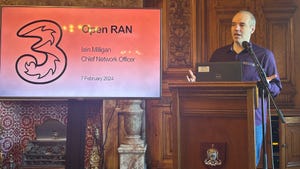AT&T's Broadband Bravado
Execs say AT&T's U-verse locations are heading for 100Mbit/s, with big wireline improvements reaching its other broadband customers, too

9:30 AM -- LAS VEGAS -- 2013 International CES -- The AT&T Inc. Developer Summit yesterday did not disappoint, and in many ways, it helped me answer the question: Where is AT&T's network going next? Of particular interest to me were the wireline network improvements noted by John Donovan, the former CTO of AT&T. Donovan's title these days is Senior Executive Vice President of AT&T Technology and Network Operations, AT&T Inc. He hopped in a car and left the Palms hotel right after the keynote session Monday morning. I was hoping to get a business card from him to see how large the cards were, given all the verbiage. What was I saying? Oh, yeah. The network ... What Donovan was clear about was that AT&T is bringing IP broadband services to more people as part of its Project Velocity IP, or Project VIP -- a menu of $15 billion worth of wireline and wireless improvements coming between now and 2015. When discussing DSLAM and wireline technologies, Donovan said: "With our plant technology advancements, 90 percent of our U-verse customer locations will have the capability to receive what we project to be 75 Mbit/s. And 75 percent will have the capability to receive up to 100 Mbit/s. "And almost 80 percent of the IP DSLAM customer locations will have the capability to receive 45 Mbit/s, with about half of those [customers] having the capability to receive up to 75 Mbit/s." He added that, in all, "75 percent of AT&T customer locations will have access to either U-verse or IP DSLAMs." Also, he reiterated the deadline, saying that AT&T will "essentially complete this IP broadband build by the end of 2015." Later, during a meeting, Jeff Weber, AT&T's VP of U-verse and Video Products, noted that AT&T already offers 35 Mbit/s to some U-verse customers today. "Our roadmap for broadband is really, really robust," he tells Light Reading. At one point I thought AT&T would run out of road by having U-verse deployed on anything less than an all-fiber network. Donovan and Weber are making the case that AT&T has plenty of technology in its own network, by taking advantage of new video compression techniques, to keep that road stretching out a long, long way. — Phil Harvey, Editor-in-Chief, Light Reading
About the Author(s)
You May Also Like


.jpg?width=300&auto=webp&quality=80&disable=upscale)









